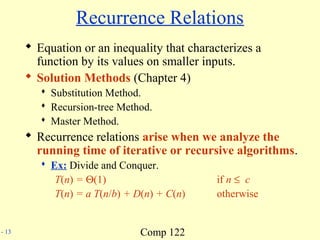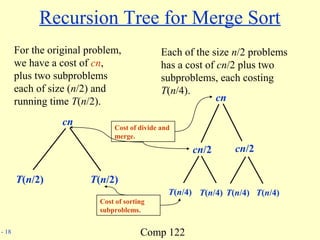This document discusses the merge sort algorithm for sorting a sequence of numbers. It begins by introducing the divide and conquer approach, which merge sort uses. It then provides an example of how merge sort works, dividing the sequence into halves, sorting the halves recursively, and then merging the sorted halves together. The document proceeds to provide pseudocode for the merge sort and merge algorithms. It analyzes the running time of merge sort using recursion trees, determining that it runs in O(n log n) time. Finally, it covers techniques for solving recurrence relations that arise in algorithms like divide and conquer approaches.




![Comp 122- 6
Merge-Sort (A, p, r)
INPUT: a sequence of n numbers stored in array A
OUTPUT: an ordered sequence of n numbers
MergeSort (A, p, r) // sort A[p..r] by divide & conquer
1 if p < r
2 then q ← (p+r)/2
3 MergeSort (A, p, q)
4 MergeSort (A, q+1, r)
5 Merge (A, p, q, r) // merges A[p..q] with A[q+1..r]
Initial Call: MergeSort(A, 1, n)](https://image.slidesharecdn.com/5-150507111225-lva1-app6892/85/5-2-divide-and-conquer-5-320.jpg)
![Comp 122- 7
Procedure Merge
Merge(A, p, q, r)
1 n1 ← q – p + 1
2 n2 ← r – q
3 for i ← 1 to n1
4 do L[i] ← A[p + i – 1]
5 for j ← 1 to n2
6 do R[j] ← A[q + j]
7 L[n1+1] ← ∞
8 R[n2+1] ← ∞
9 i ← 1
10 j ← 1
11 for k ←p to r
12 do if L[i] ≤ R[j]
13 then A[k] ← L[i]
14 i ← i + 1
15 else A[k] ← R[j]
16 j ← j + 1
Sentinels, to avoid having to
check if either subarray is
fully copied at each step.
Input: Array containing
sorted subarrays A[p..q]
and A[q+1..r].
Output: Merged sorted
subarray in A[p..r].](https://image.slidesharecdn.com/5-150507111225-lva1-app6892/85/5-2-divide-and-conquer-6-320.jpg)

![Comp 122- 9
Correctness of Merge
Merge(A, p, q, r)
1 n1 ← q – p + 1
2 n2 ← r – q
3 for i ← 1 to n1
4 do L[i] ← A[p + i – 1]
5 for j ← 1 to n2
6 do R[j] ← A[q + j]
7 L[n1+1] ← ∞
8 R[n2+1] ← ∞
9 i ← 1
10 j ← 1
11 for k ←p to r
12 do if L[i] ≤ R[j]
13 then A[k] ← L[i]
14 i ← i + 1
15 else A[k] ← R[j]
16 j ← j + 1
Loop Invariant for the for loop
At the start of each iteration of the
for loop:
Subarray A[p..k – 1]
contains the k – p smallest elements
of L and R in sorted order.
L[i] and R[j] are the smallest elements of
L and R that have not been copied back into
A.
Initialization:
Before the first iteration:
•A[p..k – 1] is empty.
•i = j = 1.
•L[1] and R[1] are the smallest
elements of L and R not copied to A.](https://image.slidesharecdn.com/5-150507111225-lva1-app6892/85/5-2-divide-and-conquer-8-320.jpg)
![Comp 122- 10
Correctness of Merge
Merge(A, p, q, r)
1 n1 ← q – p + 1
2 n2 ← r – q
3 for i ← 1 to n1
4 do L[i] ← A[p + i – 1]
5 for j ← 1 to n2
6 do R[j] ← A[q + j]
7 L[n1+1] ← ∞
8 R[n2+1] ← ∞
9 i ← 1
10 j ← 1
11 for k ←p to r
12 do if L[i] ≤ R[j]
13 then A[k] ← L[i]
14 i ← i + 1
15 else A[k] ← R[j]
16 j ← j + 1
Maintenance:
Case 1: L[i] ≤ R[j]
•By LI, A contains p – k smallest elements
of L and R in sorted order.
•By LI, L[i] and R[j] are the smallest
elements of L and R not yet copied into A.
•Line 13 results in A containing p – k + 1
smallest elements (again in sorted order).
Incrementing i and k reestablishes the LI
for the next iteration.
Similarly for L[i] > R[j].
Termination:
•On termination, k = r + 1.
•By LI, A contains r – p + 1 smallest
elements of L and R in sorted order.
•L and R together contain r – p + 3 elements.
All but the two sentinels have been copied
back into A.](https://image.slidesharecdn.com/5-150507111225-lva1-app6892/85/5-2-divide-and-conquer-9-320.jpg)













